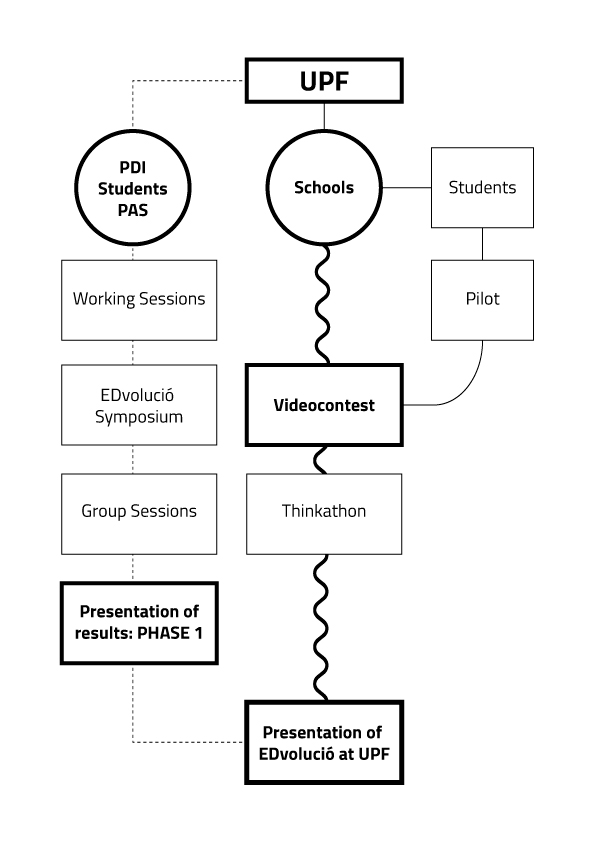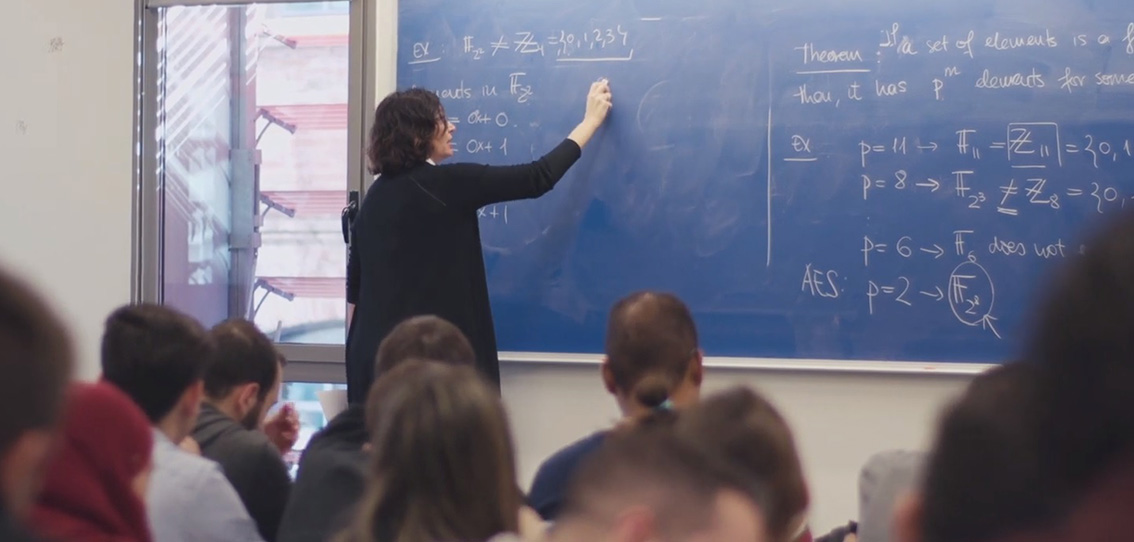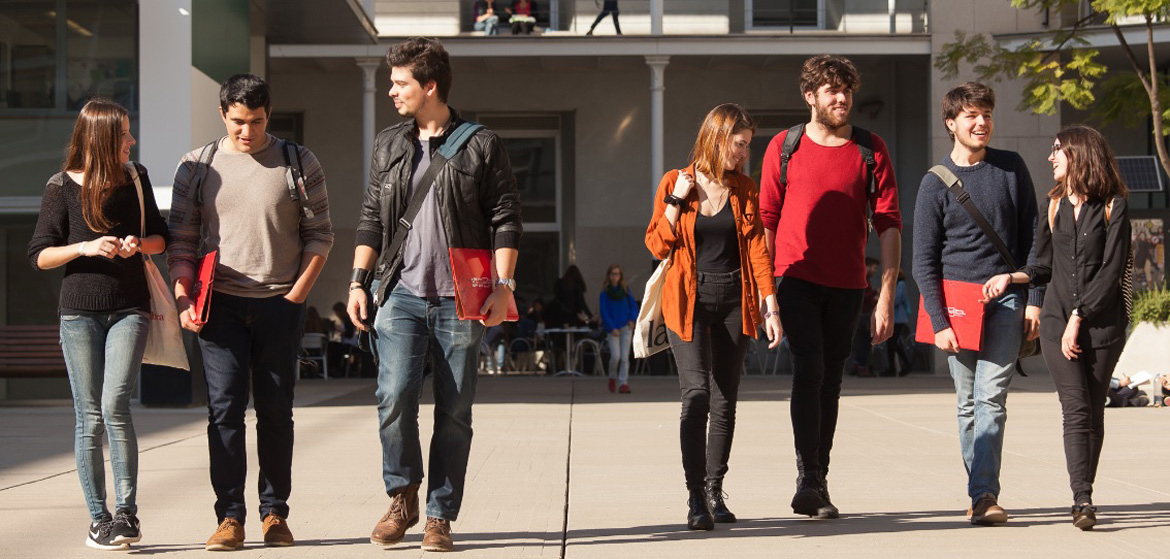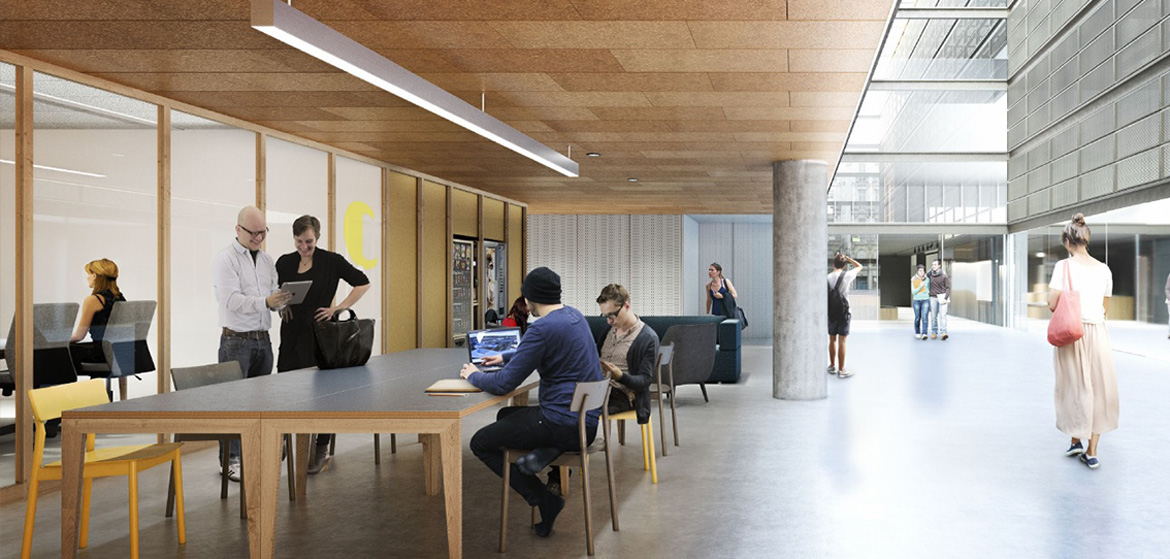Community
3. Community
EDvolution: UPF’s new education model
Society evolves, and so do universities. To respond to the new knowledge and learning challenges, Pompeu Fabra University is defining its own education model, one that reflects its singularity as an educational institution and addresses the needs of tomorrow’s professionals, companies and social agents.
‘EDvolution marks the first time in UPF’s history that the university has reflected, as an institution, on what its education model should be like. The aim is not to spark a revolution or to break with things that are working, but to evolve by introducing best practices in educational quality to provide the best service we can as a university’, said Josep Lluís Martí, vice-rector for Innovation Projects at UPF, who is responsible for leading the transformation.
The year 1999 saw the last of the major university reforms: the creation of the European Higher Education Area (EHEA). In response, UPF adapted its education model to the requirements of that reform. It has evolved accordingly in the ensuing years.
‘The aim is not to spark a revolution or to break with things that are working, but to evolve by introducing best practices in educational quality’
Since then, however, teaching and learning processes have undergone numerous social and cultural changes. As a result, in the 2017-2018 academic year, UPF decided to undertake a thorough assessment of how its education model has evolved, a model that ‘reflects its singularity as an educational institution and addresses the needs of tomorrow’s professionals, companies and social agents’, Martí explained.
According to Manel Jiménez, academic director of the Center for Learning Innovation and Knowledge (CLIK) at UPF and co-director of EDvolució, ‘We are witnessing a change in institutions and society, where learning has seeped into all areas and there is social pressure to transform how we learn.’ This change has prompted universities around the world to revise their education models to meet the new challenges. Examples range from the Monterrey Institute of Technology (TEC) in Monterrey, Mexico, and its TEC21 model, to Stanford University in the US, with its Stanford 2025 programme.
Primary and secondary schools are also playing an increasingly important role in these types of transformations. They are the first institutions to receive each new batch of students, who arrive with a very different set of expectations from those of students just ten years ago. The Escola Nova 21 network, which brings together nearly 500 schools in Catalonia, advocates changes intended to rethink education models. Changes that, sooner or later, will have to be taken up by universities too if they are to live up to the expectations of tomorrow’s university students.
According to Jiménez, EDvolution ‘is a model designed to provide students with a global vision of the world and to equip them to approach it autonomously, proactively, with a high level of technological literacy and with excellent communication skills’. However, the transformation does not affect students alone. ‘The role of teachers is changing dramatically’, he added. ‘We have to abandon the notion of teachers as unidirectional transmitters of knowledge. Today, not only is learning student-centred, so is knowledge creation.’
‘EDvolution is a model designed to provide students with a global vision of the world and to equip them to approach it autonomously, proactively, with a high level of technological literacy and with excellent communication skills.’
The project is collaborative and has sought to involve as many internal and external university stakeholders as possible. The shared leadership of the Vice-Rector’s Office for Management of Innovation Projects and CLIK has been bolstered by the involvement of a team of external consultants with expertise in the field and the creation of interdisciplinary work teams made up of UPF teaching and research staff, academic and service staff, and students. The initiative has also sought to engage the university students of tomorrow, through work with secondary schools and the direct participation of students from those schools in the design of the proposal for a new education model.

Future students have their say
The EDvolution project has sought to take future students’ opinions into account. Efforts have been made both to learn first-hand how they perceive the university today and to gather proposals for improvements that they would make to the university of tomorrow.
First, onsite workshops were held at three secondary schools in the Barcelona area — Institut Costa i Llobera, Escola Virolai and Institut Joan Salvat Papasseir — to answer basic questions about the university: Have you ever thought about what your future university will be like? Will it have exams? What will the learning spaces, sport facilities and library look like? What about the classes?
The future students’ thoughts were key to defining UPF’s new education model. They want a flexible, technological and inclusive university.
The reflection process was then brought to the university campus in the form of a ‘thinkathon’, or thinking and reflection marathon, last February. A total of 24 secondary-school students took part in the event, in addition to UPF students and alumni.
The future students’ proposals were key to helping design UPF’s new education model. They want a flexible, technological and inclusive university that:
-
Updates its teaching staff’s skills through continuing education programmes.
-
Incorporates gamification into teaching.
-
Modulates the use of social media for learning.
-
Personalizes students’ assessments.
-
Offers suitable and tutored internships to forge a real link between industry and academia.
-
Encourages international mobility through scholarships.
-
Has multifunctional, interconnected and open places, adapted to students’ new needs and to new teaching methods.
What is EDvolution organized around?
The EDvolution model was designed based on: student flexibility and versatility; cross-disciplinary learning; the integration of collaborative work between society, industry and academia; knowledge creation; and the integration of teaching and research.
To organize it, six main action areas have been defined: UPF identity, role of the teacher, student support, learning architecture, spaces and resources, and teaching formats.
1. UPF identity
The ranking system used in education has, for some time now, fostered competition between universities. To stand out, many institutions develop their own training programmes based on hallmark strengths in certain competencies that set them apart from others.
The EDvolution project defines a set of general competencies and identity policies with the aim of setting UPF students and professionals apart from those of other higher-education institutions.
Hallmark UPF competencies
-
Self-knowledge.
-
Critical and creative thinking.
-
Personal initiative and entrepreneurship.
-
Skills for adapting to and managing change in complex environments.
-
Autonomous learning, project management and problem-solving.
-
Collaborative work.
-
Interdisciplinary and cross-disciplinary learning.
-
Research skills applying the scientific method.
-
Knowledge creation and transfer.
-
Global vision of the world.
-
Personal and professional ethical integrity.
-
Commitment to social justice and sustainability.
-
Ability to assess sex- and gender-based inequalities in order to design solutions.
-
Democratic culture.
-
Competitive level of digital literacy.
-
Digital collaborative work.
-
Creation and dissemination of digital content.
-
Assolir un grau competitiu d’alfabetització digital.
-
Desenvolupar les capacitats de treball col·laboratiu digital.
-
Desenvolupar les capacitats de creació i difusió de continguts digitals.
2. Role of the teacher
EDvolution takes the assumption of new roles by teachers one step further in order to prevent them from being solely unidirectional transmitters of knowledge. The new reality is that of students with so many sources of information that one could be forgiven for (erroneously) thinking that teachers are no longer needed.
Teachers may no longer be the sole repositories of information and knowledge, but they do deliver value added, providing keys and criteria for students to learn to successfully navigate all that content.

This perspective supports the idea, already present and being carried out in some teaching initiatives, of conceiving of students as the backbone of what is learnt; subjects as all the academic activities conducted inside and outside the classroom and the varied information that students accumulate; and teachers as the point of reference responsible for organizing and transforming this volume of information into knowledge and a capacity for reflection and for designing practical actions linked to the specific discipline.
This change in their role calls for balancing how much time and effort teachers have to devote to teaching, research, knowledge transfer and management. The purpose of their work, the teaching method, the level of dedication and the assessment systems must also be reconsidered.
3. Student support
Universities must design programmes to support students in addition to classroom activities. This type of support encourages learning that is not strictly academic and fosters social bonds that have a positive impact on students’ professional futures.
However, these programmes have to focus on two very specific key moments: students’ arrival at the university (their landing) and their departure and entry into the labour market (their take-off).
The first academic term is one of the most stressful moments for first-year students. In fact, the largest percentage of university drop-outs leave school in this term, and it can seldom be made up. Consequently, an intensive student support programme will be implemented during the university’s enrolment period with two main goals: to facilitate students’ adaptation to the new educational context (information about the campus, building and classrooms; presentation of the resources and services the institution offers; information about the bachelor’s programme; information about the learning methodologies and the university’s education model; etc.) and to foster a sense of community and a feeling of belonging, encouraging new arrivals to socialize and become involved in aspects related to the university and the surrounding community.

At the other extreme, entry into the professional world after years at university is a situation that many institutions around the world are currently studying with a view to boosting both their students’ success and their own prestige. The implementation of a programme to help with the transition into the job market should thus facilitate the institution’s students’ insertion in the industrial, social and academic worlds, enable the strengthening of institutional ties, and enhance the quality of the university’s brand through better alumni relations.
4. Learning architecture
EDvolution proposes organizing the learning process to create personalized, interdisciplinary academic tracks that offer students flexibility to build their knowledge and learning curriculum and have a high degree of internationalization. The architecture of this new teaching model is intended to help students develop cross-disciplinary skills that respond to the needs of society and industry through open programmes that allow them to pursue their interests and unique academic portfolios tailored to their professional and social futures.
In this regard, a common admission path to the university makes it possible to offer a first year with certain core content for all students. In these subjects, students work on general content and develop a set of cross-disciplinary skills. This common admission path, however, does not mean students cannot specialize from the start. Instead, it allows them to design their curriculum as they go from the moment they enrol at the university and to choose the most suitable training for their specific goals.
The paradigmatic example of this is the Open Bachelor’s Degree programme, which UPF has offered since the 2015-2016 academic year, and which has been very well received by future students.
To adapt to society’s cross-disciplinary demands and to facilitate new students’ integration in the university, the creation of a common admission path for the various academic ambits at UPF has also been proposed. The first academic year of each programme would include general subjects geared towards the development of a set of basic skills, as well as specific subjects for each academic discipline.
5. Spaces and resources
UPF plans to redesign existing spaces to turn them into multipurpose rooms capable of hosting all sorts of events (tutorials, group work, talks, co-working, etc.). In particular, this reorganization must be tailored to the needs of digital natives: fixed work environments have to be eliminated and gradually replaced with flexible, liquid spaces that enable total mobility and connection. The use of digital environments and applications (Aula Global, MyApps, etc.) will play a key role in this transformation.
Taking the university’s current spaces into account, the new model proposes several changes intended to stimulate students’ imagination and creativity. Designing flexible learning environments helps universities maximize their space:
-
More large-capacity classrooms (120 to 240 people)
-
Fewer medium-capacity classrooms (60 to 90 people)
-
More small-capacity classrooms (20 to 40 people)
-
Fewer total classrooms (lower concentration of classrooms)
-
Less permanent furniture
-
Wider spaces, both in classrooms and common areas
-
More multipurpose facilities
-
Better management of the use of classrooms and other spaces so that users can book them
The Library/CRAI will also play an important role in the redefinition of the education model. Students must cease to see it as a place for intensive studying for exams. It needs to become an open space offering opportunities for them to address the full range of their potential needs.
To this end, it should include the facilities needed to realize and strengthen UPF’s new education model:
-
For teaching, research and learning: it has to be an outstanding place for learning support activities with both maker spaces and digital laboratories.
-
For collaborative work and open formats: places for meetings, meet-ups, and open-format events, such as medium-sized workshops or talks.
-
For autonomous work and learning: places for small groups, as a result of formal, non-formal and informal learning dynamics.
-
For individual work and work in isolation and silence.
-
For dialogue, conversation and debate.
-
For experimenting (with or without technology).
-
For cultural experience: a cultural facility in the broadest sense of the term, to host institutional or external exhibitions.
-
Places to rest and socialize.
Finally, the new model provides for the implementation of incubators and innovation centres that link learning with opportunities in the real world, whilst at the same time helping students build networks and find funding. The facility must also help connect students and staff with local initiatives, investors and government representatives through special programmes and events.
The transformation of the Poblenou Campus’s Workshop Area is one of the first actions to be taken in this regard. It is a place of places, of learning management and cultural production, including shared areas for intersectional and collaborative work involving teaching, research and knowledge transfer, a place where educational dynamics are carried out that go beyond official training with the aim of becoming a meeting place open to the campus and neighbourhood.

6. Educational formats
New education modalities and the inclusion of ICTs have given rise to a new way of interacting with and acquiring knowledge. Dynamics such as flipped learning, video classes, MOOCs or the cloud can effectively complement face-to-face education. Beyond lectures, today’s education also requires active and participatory methodologies that place students at the centre of the teaching-learning process and transform them into critical, practical and thoughtful individuals.
It is essential for the university to propose more flexible, accessible and integrating blended-learning teaching models for the entire student community. To this end, the number of classroom hours students must complete during their studies is being reconsidered, as are the parallel resources they are offered to supplement their training.
Face-to-face classes remain a very valuable element, but the reconsideration of the number of hours that they entail arises from the aim to make learning more effective and its outcomes more tangible.
The change facilitates access for a greater number of people as a result of the scheduling flexibility. Additionally, it offers the possibility of internationalizing some courses, makes pursuing a double degree easier and makes it more feasible for the university’s programmes to partner with external ones.
The new model’s practical application
The conclusions of the work groups, the reflections from the schools, and the expertise of the external consultants were used to design a generic base model. Now, in the second stage of the process, various academic units at UPF will integrate the model and take specific actions to implement it. The first distinctive elements of the new education model are expected to begin to be applied in the 2019-2020 academic year.
